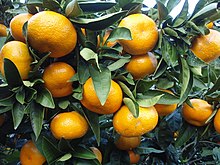
Back برتقال ساتسوما Arabic حمضيات ARZ Сацума Bulgarian Citrus unshiu Catalan Уншиу (мандарин) CV Satsuma (Frucht) German Mikano Esperanto Citrus unshiu Spanish Mandarine satsuma French Satsuma FRR
| Citrus unshiu | |
|---|---|

| |
| Scientific classification | |
| Kingdom: | Plantae |
| Clade: | Tracheophytes |
| Clade: | Angiosperms |
| Clade: | Eudicots |
| Clade: | Rosids |
| Order: | Sapindales |
| Family: | Rutaceae |
| Genus: | Citrus |
| Species: | C. unshiu
|
| Binomial name | |
| Citrus unshiu (Yu.Tanaka ex Swingle) Marcow.
| |
Citrus unshiu is a semi-seedless and easy-peeling citrus species, also known as the satsuma mandarin or Japanese mandarin.[1] During the Edo period of Japan, kishu mikans were more popular because there was a popular superstition that eating Citrus unshiu without seeds made people prone to infertility. Citrus unshiu became popular in Japan after modernization started in the Meiji period.[2] It was introduced to the West from the Satsuma region of Japan in 1878.[3]
Citrus unshiu was named after Unshu (Wenzhou), a famous production area of mandarin oranges in China, in the late Edo period of Japan. Before the name unshu mikan was established in Japan, it was called nakajima mikain or nagashima mikan after the place name of Nishi-Nakajima in Amakusa District of the Higo Province (later Nagashima, Kagoshima), where the species was thought to have developed by mutation.[4][2] It is said to have originated in either Japan[5][4][2] or China, and because of its name, it is often described as originating in China.[3][6][7] Genetic studies conducted in the 2010s suggest that the maternal species of Citrus unshiu is kishu (Citrus kinokuni) and the paternal species is kunenbo (Citrus nobilis Lour. var. kunip).[8][9]
Various cultivars have been developed based on the Citrus unshiu, and in Japan, three cultivars, namely miyagawa wase, okitsu wase, and aoshima unshu, account for nearly half of the production volume of Citrus unshiu.[10]
- ^ Michel H. Porcher (ed.). "Sorting Citrus names". Multilingual Multiscript Plant Name Database. The University of Melbourne.
- ^ a b c "日本と世界の食事情「こたつでミカン」の光景はなぜ生まれたのか" [Food situation in Japan and the world. How did the scene of eating mikan at a kotatsu come about?]. Narumi Sato (in Japanese). Japan Business Press Co., Ltd. February 1, 2019. p. 3. Archived from the original on February 5, 2019. Retrieved June 30, 2021.
During the Edo period, when kishu mikan were being cultivated, unshu mikan were already being cultivated. However, they were not yet called unshu mikan, but Nakajima mikan. Although mandarins were a luxury, unshu mikan were not the most popular. The unshu mikan is unique in that it is ready to peel and has no seeds. The lack of seeds is good because they are easy to eat, but in the Edo period, the lack of seeds was a factor that made them unpopular. It was believed that eating seedless fruit meant that one could no longer produce offspring, thus ending one's family lineage. When the fruit was named "unshu mikan" in the late Edo period, it was finally recognized. Wenzhou is a mandarin production area in China, and the name "unshu mikan" means "a mandarin comparable to the one produced in Wenzhou". The unshu mikan is often mistaken for a mandarin imported from China, but it is a genuine Japanese mandarin. It was not until the Meiji period that the cultivation of unshu mikan became popular.
- ^ a b The Satsuma Mandarin University of Florida
- ^ a b Misaki, Akira (November 1999). "紀州有田みかんの起源と発達史" [The Origin and the Development-Process of "Kisyu Arida Mikan (Arida Mandarin)"]. 経済理論 [The Wakayama Economic Review] (in Japanese). 292. University of Wakayama: 97–118. Archived from the original on 2002-07-01.
(After the many years of research, Dr. Tanaka has concluded the place of origin of Satsuma is Nagashima, Kagoshima. Satsuma is a chance seedling of Sōkitsu, Mankitsu, or Tendaisankitsu introduced from Huangyan Zhejiang, China. It appeared in the early Edo period. The place where Satsuma was born by mutation was Nishi-nakajima, Amakusa District, Higo Province (later Nagashima, Kagoshima), and was called Nakajima Mikan or Nagashima Mikan.)
- ^ "Hybrid Origins of Citrus Varieties Inferred from DNA Marker Analysis of Nuclear and Organelle Genomes" (PDF). Shimizu Tokurou; Kitajima Akira; Nonaka Keisuke; Yoshioka Terutaka; Ohta Satoshi; Goto Shingo; Toyoda Atsushi; Fujiyama Asao; Mochizuki Takako; Nagasaki Hideki; Kaminuma Eli; Nakamura Yasukazu. November 30, 2016. p. 50. Archived from the original (PDF) on April 26, 2019. Retrieved June 30, 2021.
Therefore, it is likely that kunenbo was backcrossed to kishu in the Kagoshima region of Japan several times and Satsuma and Yatsushiro were selected from their offspring.
- ^ Schlegel, Rolf (2009). Dictionary of Plant Breeding (2nd ed.). CRC Press. p. 437. ISBN 9781439802434.
- ^ "Japanese Mikan and Satsuma Oranges". hawaii.edu.
Mikan is a tangerine-like citrus fruit that is grown in warmer regions of Japan in large quantities. Many different varieties have been introduced to Japan from China since the eighth century, but since the late 19th century the most important variety has been the unshu.
- ^ "Parental diagnosis of satsuma mandarin (Citrus unshiu Marc.) revealed by nuclear and cytoplasmic markers". Hiroshi Fujii, Satoshi Ohta, Keisuke Nonaka, Yuichi Katayose, Toshimi Matsumoto, etc. November 30, 2016. Archived from the original on June 30, 2021. Retrieved June 30, 2021.
- ^ Cite error: The named reference
narowas invoked but never defined (see the help page). - ^ 温州ミカン品種別栽培面積 (in Japanese). National Agriculture and Food Research Organization. Archived from the original on 26 July 2021. Retrieved 23 May 2023.
© MMXXIII Rich X Search. We shall prevail. All rights reserved. Rich X Search